Nestled in the heart of the Midwestern United States, Ohio is filled with picturesque landscapes and incredible wildlife. With its abundant wetlands, lakes, and rivers, the state is a natural sanctuary for a wide variety of different turtles. Let’s look at the 12 turtles of Ohio, from the rarest species to the most common!
12. Ouachita Map Turtle (Graptemys ouachitensis)
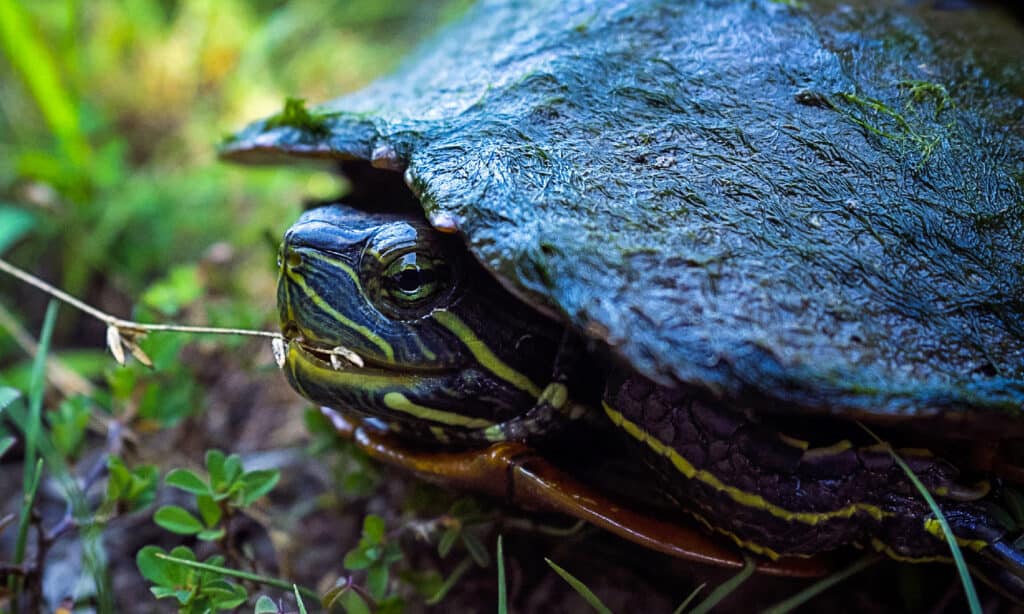
It is difficult to tell the difference between an Ouachita map turtle and a northern map turtle.
©Stephanie’screativeImages/Shutterstock.com
The rarest turtle in Ohio is the Ouachita map turtle. These rare turtles are a Species of Special Concern in the state, found only in the Scioto River and its associated oxbows. Ouachita map turtles have dark brown or olive-colored shells and yellow markings on their faces. Female Ouachita map turtles typically have 5 to 10.75-inch-long shells, while males’ shells are only 3.5 to 5.75-inch long.
11. Spotted Turtle (Clemmys guttata)
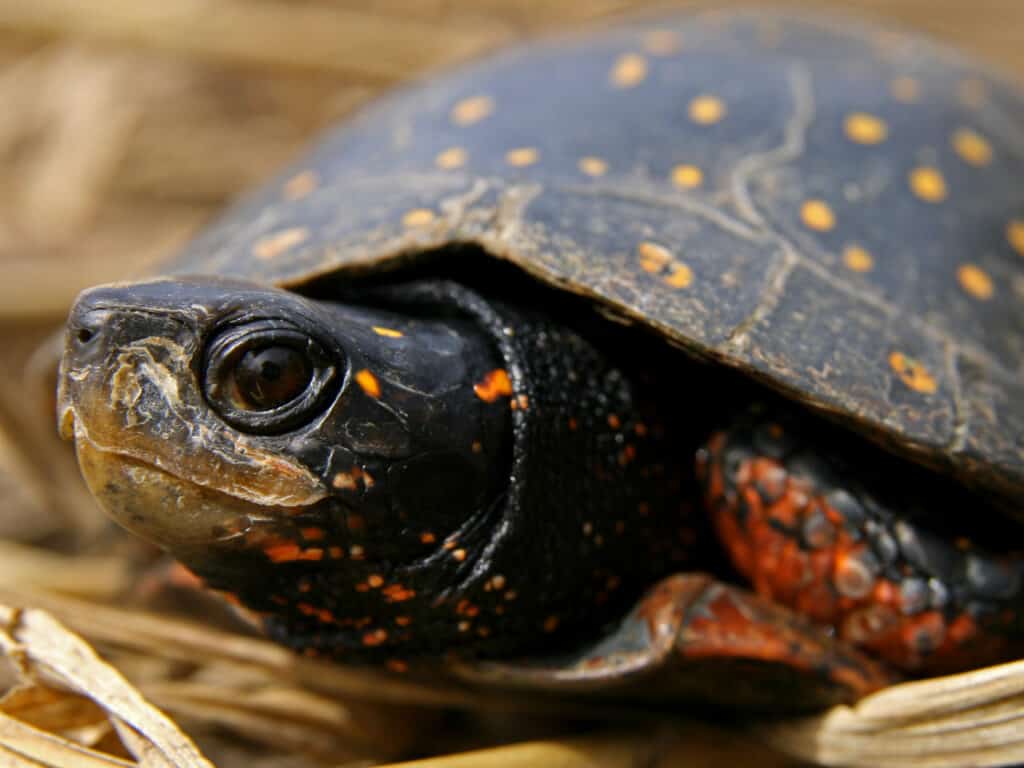
Male spotted turtles have tails that are thicker and shorter than females.
©Ryan M. Bolton/Shutterstock.com
The spotted turtle is another extremely rare species in Ohio. Today it is only found in two isolated areas in the northwestern part of the state. Spotted turtles are semi-aquatic, with smooth, dark shells that are 3 to 4 inches long. There are bright yellow spots on their bodies and the top of their shells. Spotted turtles prefer living in slow and shallow water with lots of vegetation. However, due to human alteration of wetlands, much of the spotted turtle’s natural habitat has been destroyed.
10. Blanding’s Turtle (Emydoidea blandingii)
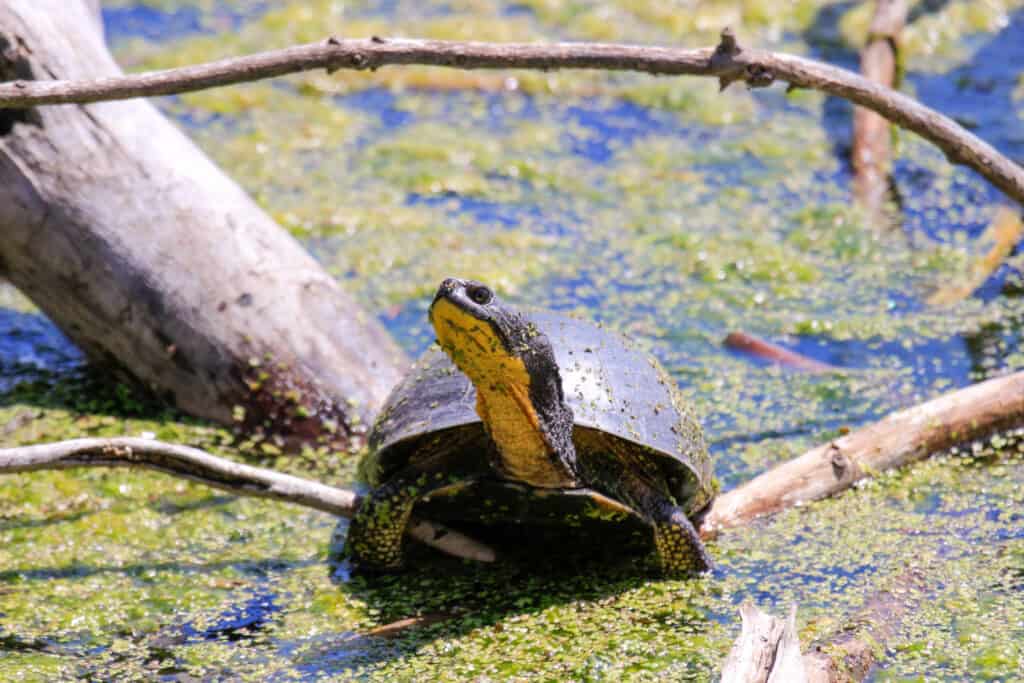
Blanding’s turtles are shy and timid creatures.
©iStock.com/mynewturtle
Blanding’s turtle, another extremely rare animal in Ohio, is also an endangered species. These rare turtles mainly live in Ohio’s northern counties along Lake Erie. They are mostly aquatic and prefer habitats like wet meadows, inland streams, and marshy shorelines. They have large shells that measure 7 to 10 inches long. You can often spot a Blanding’s turtle from a distance due to the bright yellow coloring on their chins and throats.
9. Woodland Box Turtle (Terrapene carolina)

Woodland box turtles are the most terrestrial turtles in Ohio.
©Mark_Kostich/Shutterstock.com
The woodland box turtle (or eastern box turtle) is another Species of Special Concern in Ohio. These extremely gentle creatures are rare throughout the state, mainly due to loss of habitat and careless drivers. Woodland box turtles spend much of their time hiding beneath plant debris and logs, especially when it gets hot. They have dark brown or black shells, which grow 4.5 to 6 inches long. Their shells also have a variety of different yellow markings, blotches, or streaks. These unique turtles have a hinged lower shell. This allows woodland box turtles to pull their lower shells up tight against their upper shells, essentially creating a protective “box” around their bodies.
8. Wood Turtle (Glyptemys insculpta)

Adult wood turtles have bright yellowish-orange colors on their legs and throats.
©Jay Ondreicka/Shutterstock.com
The wood turtle is another rare and endangered species in Ohio. They can occasionally be spotted in the northeastern part of the state. Wood turtles grow 5.5 to 7.9-inch-long shells, which are brown, grayish-brown, or tan. The top part of their shells has large pyramid-shaped plates. Younger turtles often have black and yellow lines or fan-shaped markings that fade as they get older.
7. Smooth Softshell Turtle (Apalone mutica)
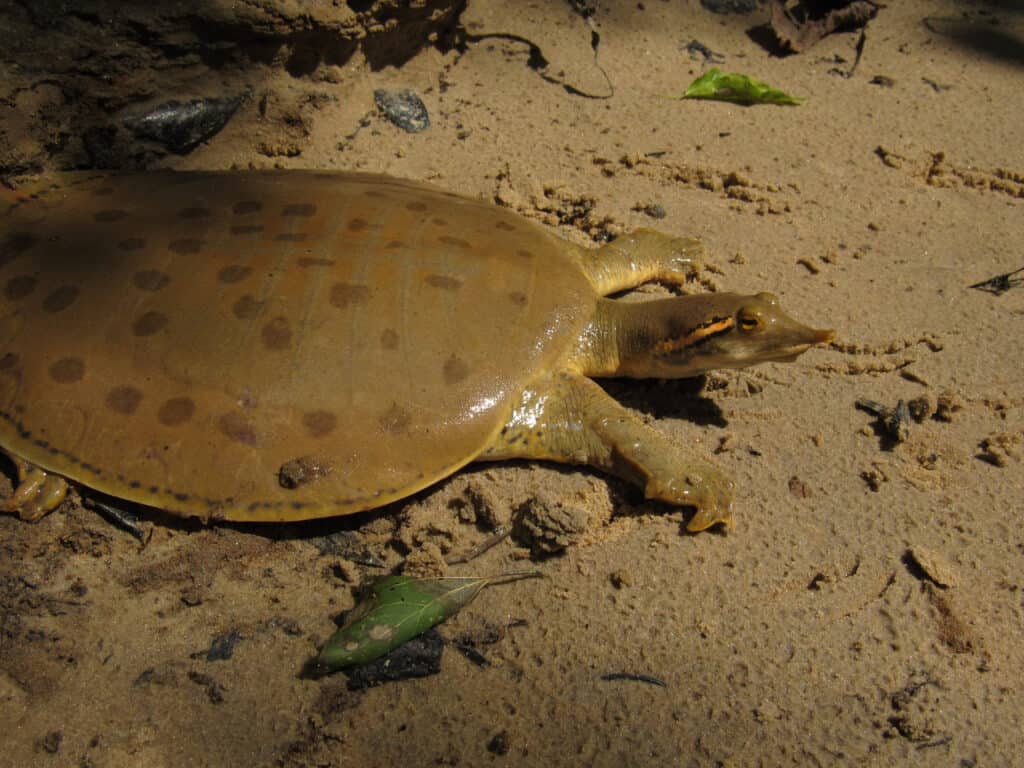
Softshell turtles have a smooth carapace or upper shell.
©Gabbie Berry/Shutterstock.com
Found mostly in Ohio’s river systems, smooth softshell turtles are less common than many other species in the state. They live mostly in the south and southeastern areas of Ohio, such as in the Ohio River and Scioto River. Instead of thick, plated shells, these unique turtles have a soft shell with a tough, rubbery covering. They aren’t as heavily protected as other turtles, but what they lack in armor they make up for in speed, agility, and incredible swimming skills.
6. Midland Painted Turtle (Chrysemys picta marginata)
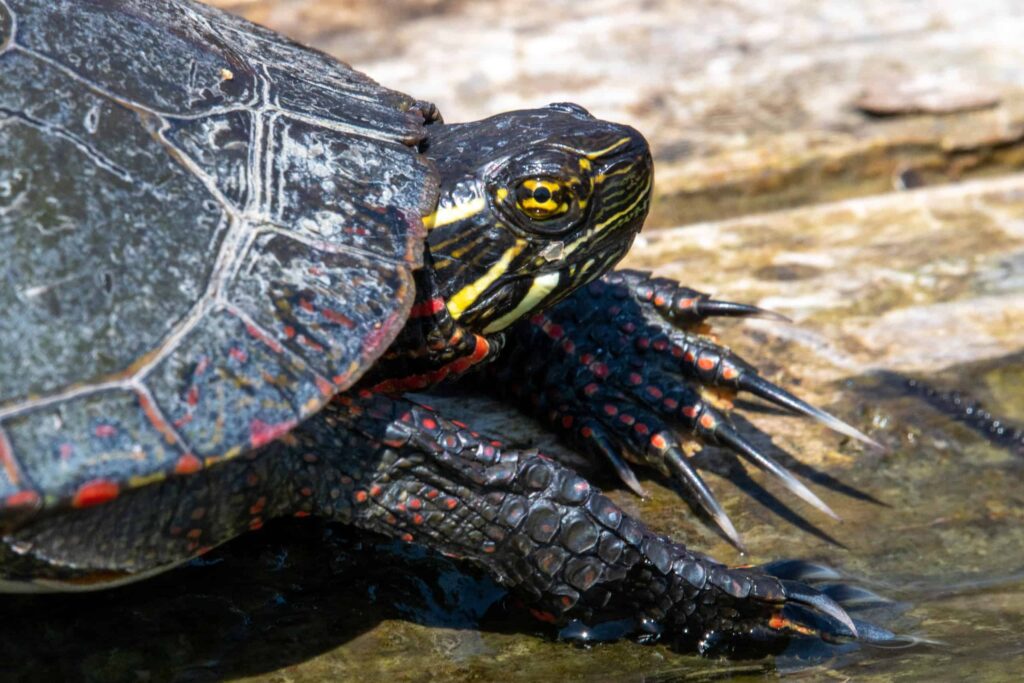
There is usually red coloring along the bottom of a midland painted turtle’s shell.
©Lindaimke/Shutterstock.com
Midland painted turtles are fairly common in Ohio, primarily in the central, northern, and eastern areas of the state. These colorful creatures live in quiet, shallow bodies of freshwater like marshes, wetlands, ponds, and lakes. Their shells are brown or dark green and typically measure 3 to 10 inches long. Their name, however, comes from their beautifully patterned bodies, which have bright red, orange, and yellow markings on them.
5. Common Musk Turtle (Sternotherus odoratus)
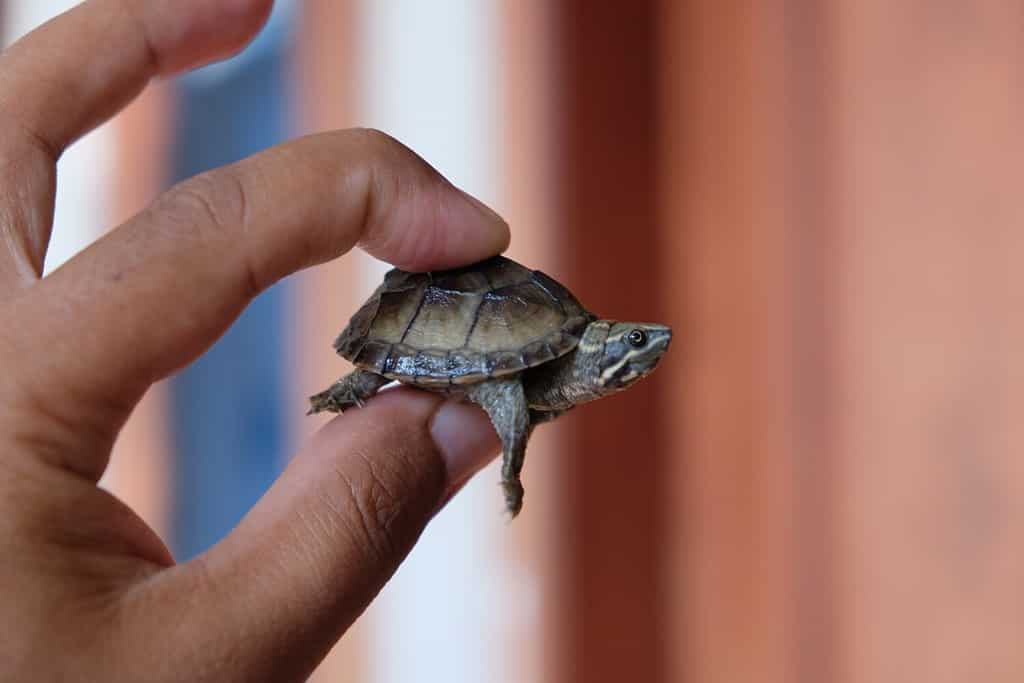
Common musk turtles grow a shell that is just 2 to 5.5 inches long.
©forest warrior/Shutterstock.com
The common musk turtle (or eastern musk turtle) is rarely seen outside of water. It prefers to spend most of its time in still or sluggish water with a muddy bottom and lots of plants. Common musk turtles are fairly common in the wetland habitats or shallow parts of Ohio’s rivers and lakes. Their shells grow 2 to 4 inches long, and they have two bright yellow stripes on each side of their heads. Common musk turtles are often called “stinkpots” or “stinkpot turtles” due to the foul odor expelled when they feel threatened.
4. Spiny Softshell Turtle (Apalone spinifera)

Spiny softshell turtles are incredibly skilled swimmers and can be rather aggressive at times.
©Matt Jeppson/Shutterstock.com
A rather peculiar turtle in Ohio is the spiny softshell turtle, which typically lives in lakes and large rivers throughout the north-central areas and northwestern corner of the state. Like their smooth-shelled cousins, spiny softshell turtles have a tough, rubbery covering on their soft shells, but with a few additional features. Spiny softshell turtles also have tiny, cone-shaped spines on the front of their shells. Males have shells measuring 5 to 9 inches long, while female shells are 7 to 17 inches long.
3. Northern Map Turtle (Graptemys geographical)

Northern map turtles are endemic to North America.
©iStock.com/PaulReevesPhotography
Found in many of Northern Ohio’s lakes and larger rivers, the northern map turtle is common but not often seen. These turtles are extremely cautious and quickly dive into deep water when they sense a threat. They don’t need to return to the water’s surface to breathe and often spend the entire winter deep within the water. If you’re lucky, you might even see them walking along the bottom of a lake far beneath the ice! Northern map turtles have delicate yellow crisscrossing lines on the top of their shells. Their name comes from these markings, which look somewhat like a topographic map.
2. Red-Eared Slider (Trachemys scripta elegans)

Red-eared slider turtles are very popular pets.
©iStock.com/slowmotiongli
A rather common turtle in Ohio is the red-eared slider. Red-eared sliders have a distinctive red marking behind each eye and their shells are typically 5 to 8 inches long. Unfortunately, most of the red-eared sliders in Ohio (except for in a few southern areas) are discarded pets or their descendants. It is important to note that not only is releasing a pet turtle into the wild against the law, but it also endangers natural wildlife.
1. Common Snapping Turtle (Chelydra serpentina)
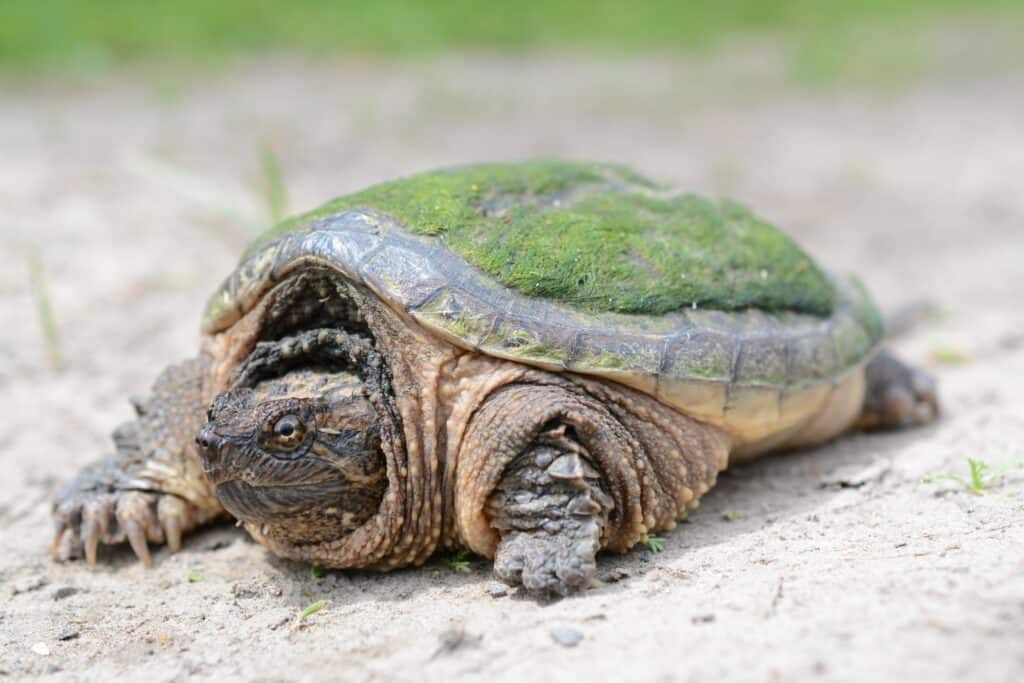
Snapping turtles
have very powerful, beak-like jaws with sharp edges that can do a lot
of damage.
©Trevor Meunier/Shutterstock.com
The largest and most common turtle in Ohio is the common snapping turtle — although you are unlikely to see very many! Despite their abundant numbers and large bodies, snapping turtles don’t spend a lot of time out in the open. They prefer hanging out in freshwater or brackish water habitats with lots of vegetation and muddy bottoms. Common snapping turtles are quite large, with a 10 to 20-inch-long shell that can weigh over 35 pounds! In addition, they are also bold and aggressive animals.
Summary of the 12 Turtles of Ohio: The Rarest to the Most Common
| Common Name | Scientific Name |
|---|---|
| Ouachita Map Turtle | Graptemys ouachitensis |
| Spotted Turtle | Clemmys guttata |
| Blanding’s Turtle | Emydoidea blandingii |
| Woodland Box Turtle | Terrapene carolina |
| Wood Turtle | Glyptemys insculpta |
| Smooth Softshell Turtle | Apalone mutica |
| Midland Painted Turtle | Chrysemys picta marginata |
| Common Musk Turtle | Sternotherus odoratus |
| Spiny Softshell Turtle | Apalone spinifera |
| Northern Map Turtle | Graptemys geographica |
| Red-Eared Slider | Trachemys scripta elegans |
| Common Snapping Turtle | Chelydra serpentina |
The photo featured at the top of this post is © iStock.com/mynewturtle
Thank you for reading! Have some feedback for us? Contact the AZ Animals editorial team.






